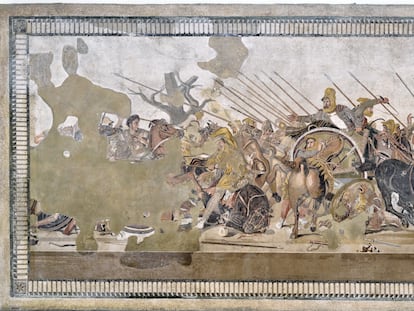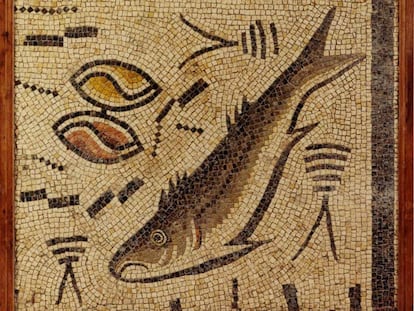Ancient Roman mosaic returns to Spain after 8,768-mile journey
The artifact was sold and subsequently lost in the international art market before being rediscovered in New York in 2018. After an arduous process of purchase and repatriation, the historic piece has finally returned home thanks to the determination of local residents
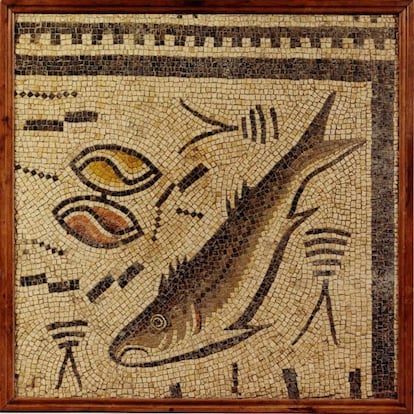
It was created in the third century to remain forever in its original location, yet since its discovery on a private estate during construction work sometime before 1850, it has traveled at least 8,768 miles across the globe, only to return to its starting point in the Spanish city of Nigrán. Spanish lawyer Gonzalo Fernández-Turégano calculated this incredible journey and shared the details via WhatsApp, using the in-flight Wi-Fi on his way to New York. His message came just as the Roman Mosaic of Panxón was finally returned to its homeland this Wednesday, following a long and arduous odyssey.
The mosaic, depicting a marine scene, was for many years was like a ghost — a fragment of history known only through mentions in old texts, descriptions, and faded photographs from scholars of the past. Its physical trace had vanished amid the twists and turns of the international art market. That changed in 2018, when Fernández-Turégano, an avid admirer of art, books, museums, and galleries, rediscovered the mosaic in the collection of the Carlton Hobbs antiques house in Manhattan’s Upper East Side.
As a child, Fernández-Turégano was already captivated by history and art. He vividly recalls being fascinated by a black-and-white photograph of the mosaic in a thick book on the history of the Vigo area, which he discovered at his aunt and uncle’s house. The image depicted a fragment — almost a meter square — that survived from a much larger Roman mosaic, long since destroyed. This mosaic had once adorned a room in an ancient villa at O Castro de Panxón, a peninsula caressed by the waves of Nigrán, a municipality in Pontevedra, in the Spanish region of Galicia.
The fragment featured a mullet and a pair of clams, rendered in tesserae now known to have been vibrantly colored. These marine creatures appeared on a sea depicted with brush-like strokes called “water flies,” a motif common in other Iberian mosaics with oceanic themes. The accompanying text in the book included insights from the late archaeologist Fernando Acuña Castroviejo, who had traced the mosaic’s history.
For decades, this marine mosaic, which had captivated Fernández-Turégano during his childhood vacations in Galicia, remained etched in his memory. Now a lawyer and banking executive based in Madrid, that early fascination would resurface and lead to a remarkable rediscovery.
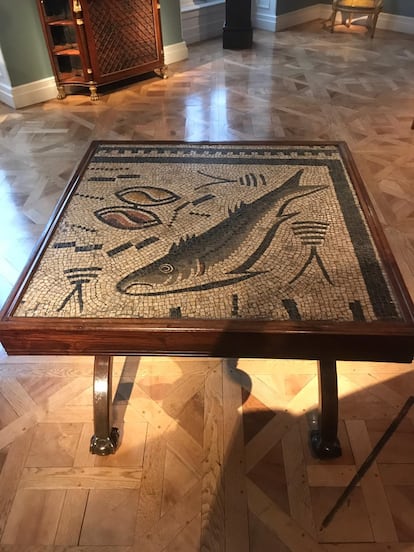
Seven years ago, Fernández-Turégano rediscovered this historical gem “by chance” while browsing the Carlton Hobbs catalog. He partnered with a group of friends, family members, art experts, and Nigrán residents to spearhead a grassroots initiative to recover the mosaic and return it to its homeland. With support from the local City Council — which contributed €40,000 ($41,650) — and a crowdfunding campaign, the Association for the Repatriation of the Mosaic successfully raised the necessary €58,000 ($60,000) in 2022 to purchase the piece. The mosaic, preserved within a 19th-century table, was finally secured.
The recovery process was slow and, at times, discouraging. “We faced a thousand difficulties,” recalls Fernández-Turégano. “When we were setting up the association, the Covid-19 pandemic hit; the crowdfunding was slow; the seller agreed to deliver the mosaic in London, but Brexit introduced a new hurdle — import VAT to Spain. It took months to secure an exemption,” he explains. “But in the end, thanks to the financial support of the Nigrán City Council and the generosity of friends and donors, we achieved our goal,” he says, celebrating as he flies over the Atlantic.
Late Wednesday, the table containing the Roman mosaic fragment departed Madrid for Nigrán. Meanwhile, Mayor Juan González closely followed updates from the transport company, monitoring the cargo’s journey home.
The mosaic is now officially owned by the Nigrán City Council, following an official ceremony last Saturday at the Colnaghi gallery in Madrid — three years after its purchase was finalized. The artifact had arrived at Colnaghi’s London branch, the European collaborator of Carlton Hobbs, in March 2023. There, it awaited repatriation for over a year and a half, finally returning to Spain in late November 2024 after a quarter-century in exile.
Since its return, the mosaic has been on display, and on Wednesday it completed the final 372 miles of its eventful journey. It will now be exhibited in the plenary hall of this coastal municipality as part of a museum project led by Árbore Arqueoloxía, the company responsible for excavations in the area. The mosaic will remain there temporarily until a permanent exhibition space is established.
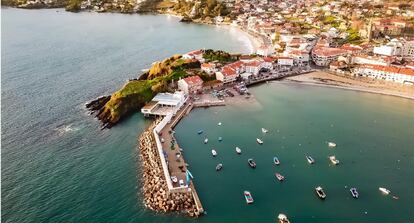
According to Acuña Castroviejo (1945–2016), who documented the mosaic’s existence in the 1970s, the Puga family of Nigrán discovered this treasure sometime before 1850 during construction work on their seaside property. Originally part of a much larger mosaic, the Puga family managed to save a single fragment from destruction, embedding it in a Roman-style scissor table to preserve it. The first recorded owner was Umbelina González Lavandeira, “widow of Mr. Puga,” as noted in a 19th-century manuscript.
Over time, the family sold the table to Ricardo Blanco-Cicerón, one of Galicia’s most renowned art collectors, who passed away in 1926. After decades of obscurity, the mosaic resurfaced in 2000 at Castellana Subastas in Madrid, where it was purchased by a Danish bidder for just under two million pesetas (around $12,000). By 2012, the mosaic had made its way to New York, though its whereabouts remained unknown in Galicia until six years later, when Fernández-Turégano stumbled upon the familiar fish motif that had been etched in his memory since childhood. He had found it by chance while browsing a Carlton Hobbs catalog online.
“On a trip to New York I made an appointment to see it,” Fernández-Turégano explained to EL PAÍS two years ago. “[Hobbs] had no idea about its origin, although the then curator of Roman art at the Metropolitan Museum, Carlos Picón, had identified it as a 3rd-century Lusitanian mosaic. I said that I was interested in repatriating it, and he said that if the intention was to exhibit it, he would be willing to lower the price, from $75,000 to $58,000.”
In October 2020, the newly formed Association for the Repatriation of the Panxón Roman Mosaic signed a booking agreement with Hobbs, a dealer specializing in European aristocratic furniture, and his gallery manager, Stefanie Rinza. “Our job is to ignite the spark and then step into the background. We leave the glory of cutting the ribbon to the politicians,” said Fernández-Turégano, who, alongside friends and neighbors of Nigrán, championed the mosaic’s return from start to finish. However, the Madrid-based lawyer was unable to be in Galicia to witness the final chapter of the mosaic’s extraordinary journey.
Panxon’s archaeological remains
According to the 19th-century manuscript cited by Acuña Castroviejo, the preserved mosaic fragment is just a corner of a larger scene that may have included elements resembling “castles” and “dolls.” However, much of the mosaic was tragically “thrown away,” as the manuscript recounts, leaving only this small remnant. The discovery site — a rocky crag separating two beaches near the Panxón fishing port — was never properly excavated. Yet, the local toponym “O Castro” has long hinted at the secrets hidden beneath its private estates, buildings, yacht club, pier, and summer villas.
Over the years, a series of accidental discoveries confirmed the area’s rich Roman history: a pottery workshop, an altar dedicated to Mercury, and amphorae fished from the bay by local sailors.
Between New Year’s Eve 2022 and New Year’s Eve 2023, while the mosaic waited to travel from London, nature unveiled more of Panxón’s ancient secrets. A fierce storm caused part of the cliff to collapse, exposing hundreds of archaeological remains — grinding stones, pottery, bones, and building materials from two millennia ago.
Remarkably, the first person to discover these artifacts and raise the alarm was Gustavo Pascual, an archaeologist, history teacher, and second vice-president of the Association for Repatriation. A neighbor of the area and a key figure in the mosaic’s rescue, Pascual had ventured out for a walk during a break in the storm, only to stumble upon the extraordinary find.
Sign up for our weekly newsletter to get more English-language news coverage from EL PAÍS USA Edition
Tu suscripción se está usando en otro dispositivo
¿Quieres añadir otro usuario a tu suscripción?
Si continúas leyendo en este dispositivo, no se podrá leer en el otro.
FlechaTu suscripción se está usando en otro dispositivo y solo puedes acceder a EL PAÍS desde un dispositivo a la vez.
Si quieres compartir tu cuenta, cambia tu suscripción a la modalidad Premium, así podrás añadir otro usuario. Cada uno accederá con su propia cuenta de email, lo que os permitirá personalizar vuestra experiencia en EL PAÍS.
¿Tienes una suscripción de empresa? Accede aquí para contratar más cuentas.
En el caso de no saber quién está usando tu cuenta, te recomendamos cambiar tu contraseña aquí.
Si decides continuar compartiendo tu cuenta, este mensaje se mostrará en tu dispositivo y en el de la otra persona que está usando tu cuenta de forma indefinida, afectando a tu experiencia de lectura. Puedes consultar aquí los términos y condiciones de la suscripción digital.
More information
Archived In
Últimas noticias
Charles Dubouloz, mountaineering star, retires at 36 with a farewell tour inspired by Walter Bonatti
From the White House to diplomatic gifts: Lego wins over adult fans, brick by brick
Kate Winslet makes her directorial debut: ‘There aren’t more female directors because we’re busy raising children’
ChatGPT fails the test: This is how it endangers the lives of minors
Most viewed
- Families demand repatriation of bodies of Colombians who died in Ukraine: ‘This war is a slaughterhouse for foreigners’
- The low-cost creative revolution: How technology is making art accessible to everyone
- Liset Menéndez de la Prida, neuroscientist: ‘It’s not normal to constantly seek pleasure; it’s important to be bored, to be calm’
- Christian Louboutin: ‘Young people don’t want to be like their parents. And if their parents wear sneakers, they’re going to look for something else’
- Christmas loses its festive spirit: ICE fears cast shadow over religious celebrations
